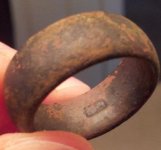OK, I found a brass ring marked 18K (not the one in the picture, but just like it, can't find my camera usb cable) yesterday in the middle of a large Union camp. It was around 5" deep. After surfing the net, I've found more questions than answers about it. First off I know it was sold as a fake as it is brass. Secondly, I know everything found on a Civil War site is not of the period. And thirdly, I know that in 1906 the US passed a law that all jewelry had to marked as to metal content. There seems to be a raging debates on several forums, concerning these rings, about whether CW soldiers wore them or not. My question to all of you, that have found one of these, is where did you find it? I would be very interested to know how many others have come off of CW sites.
Amazon Forum Fav 👍
Attachments
Upvote
1






